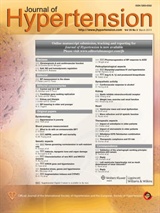Incident hypertension and its predictors :the Isfahan Cohort Study
Authors
Affiliations
- 1aCardiovascular Research Center bCardiac Rehabilitation Research Center, Isfahan Cardiovascular Research Institute, Isfahan University of Medical Sciences, Isfahan cDepartment of Neurology, Tehran University of Medical Sciences, Tehran, Iran dSaw Swee Hock School of Public Health, National University of Singapore, Singapore.
Abstract
Objectives: The present study aimed to investigate the incidence and predictors of hypertension in an Iranian adult population.
Methods: Isfahan Cohort Study was a longitudinal population-based study that was conducted on adults aged 35 years or older, living in urban and rural areas of three districts in central Iran. After 7 years of follow-up, 3283 participants were re-evaluated using a standard protocol similar to the baseline. At both measurements, participants underwent medical interview, physical examination, and fasting blood measurements. Participants (n = 833) with prevalent hypertension were excluded from the analysis, resulting in a sample size of 2450.
Results: The participants’ age was 47.3 ± 9.4 years (mean ± SD) and 50.7% were men. During the follow-up period, 542 (22.1%) individuals developed hypertension, 49.6% of whom were aware of their disease, 42.4% were treated, but only 24.9% were controlled. Incidence rates have shown no sex-specific difference across age and blood pressure (BP) categories. Multivariate-adjusted model controlled for all study covariates showed that age, male sex, general and central obesity, hypertriglyceridemia, impaired fasting glucose, diabetes mellitus, baseline BP at least 120/80 mmHg (nonoptimal BP), and parental history of hypertension independently contributed to the development of hypertension. Higher education level and more than 10% decrease in waist circumference over 7-year follow-up represented protective effects. In men, weight loss decreased and weight gain increased the risk of developing hypertension. Nonoptimal BP along with central obesity and hypertriglyceridemia together were responsible for 71% of the burden of hypertension.
Conclusion: Our findings imply that there are other factors in addition to nonoptimal BP that deserve integrating into the risk assessment criteria for developing hypertension.

